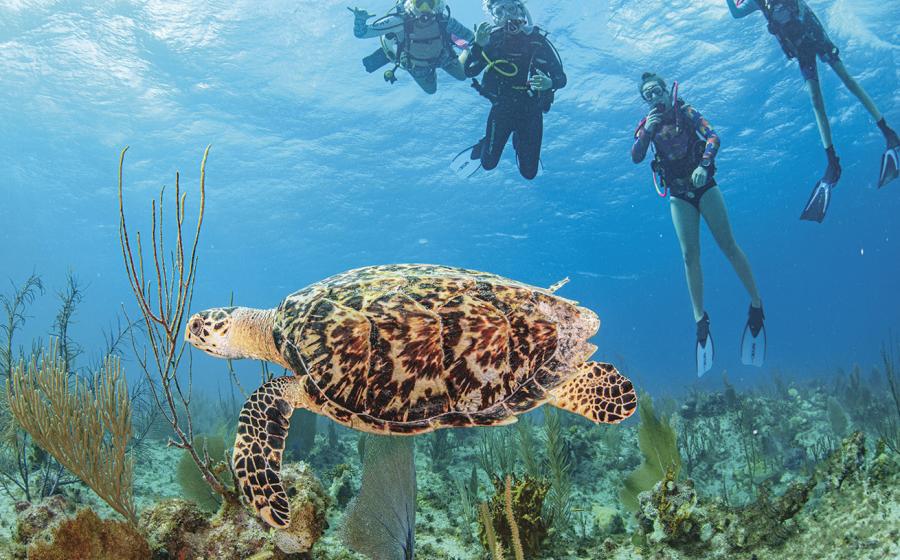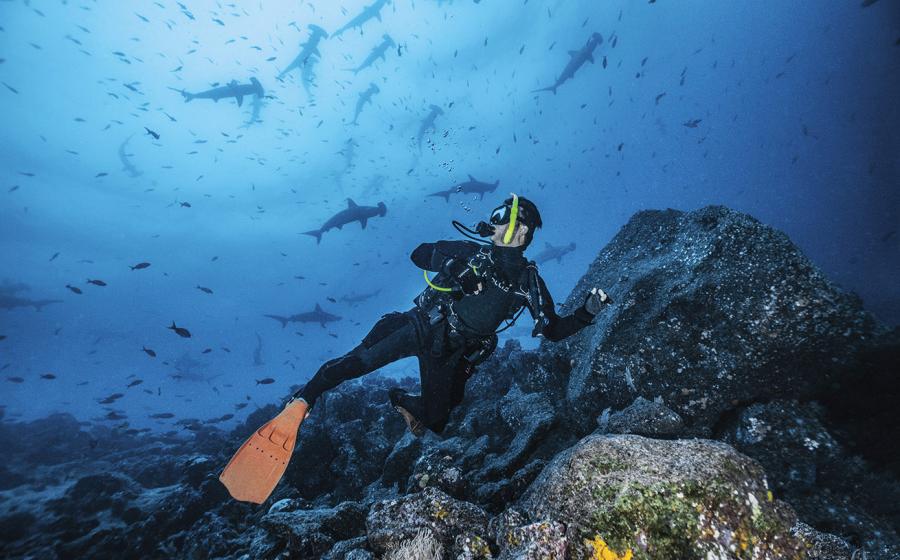The Secret Paradise
The blue throat pike blenny is an exotic sea creature few people ever see. Those who do are amazed by the ferocious territorial display the tiny dragons exhibit. I felt privileged to observe this dramatic behavior during one of my unforgettable critter dives off St. Vincent.Our boat had dropped anchor at a site called Critter Corner in a protected bay not five minutes from the Young Island Dock. I looked down to discover a shallow plain of sand and eelgrass. Despite the drab appearance, years of ''muck diving'' had taught me that this kind of seabed had the potential for hosting a wealth of unusual marine life. My guide was Bill Tewes of Dive St. Vincent, who has spent thousands of dives exploring these waters. The Texas-born expatriate evoked all of the storybook traits of Merlin: the silver bush of a beard, the long cue descending down his back and especially the magical way he surprised me during this and subsequent dives by uncovering the most amazing hidden sea creatures. With a gentle kick he began a tour that has seldom been rivaled in my underwater photography and marine biology explorations worldwide. First we watched flying gurnards posing like underwater peacocks, followed by a longsnout seahorse as tall as a toothbrush, which is gigantic for these piscine oddities. Later in the dive, I was observing cleaner shrimps and an array of crabs when Bill signaled for me to join him beside a huge boulder. He pointed at a collection of yellow tube sponges with a tennis ball-sized lump in the middle. Looking closer, I spotted the eye of a frogfish, an unusual anglerfish rarely seen by divers. I shot a couple of quick portraits before Bill motioned me over to a purple sponge. I couldn't believe my eyes. Yet another frogfish was waiting to pose for pictures.The encounter with the courageous blenny came as we headed back to the boat. We had passed two buried snake eels, more flying gurnards, a plumed scorpionfish and an electric ray when I spotted the sand-dwelling dragon.Olive-colored and roughly the size of four pipe cleaners twisted together, it was the most dramatic specimen I have ever seen. Orange eyes blazing, the blenny flared its fins aggressively as I drew closer in a display that made it very clear my intrusive behavior would not be tolerated. Merlin and I hurried to the boat for more film.
Exotic AbundanceEarly the next morning we ventured out to a dive site called Steps. Within 15 minutes, Bill cut the engines and tied up to a mooring. (Most of the 20 or so sites commonly dived on St. Vincent are equipped with moorings to prevent anchor damage.)The site was named for the carved steps that descend down a cliff face and serve as a backdrop for the horseshoe-shaped dive site. More than 100 years ago these steps delivered patients from a leper colony down to a carved basin where they could bathe in the therapeutic seawater.Unlike Critter Corner, this site featured lava ledges cloaked in corals and sponges. Between the ledges was a forest of extraordinary gorgonians. The 10-foot-tall colonies of plumed soft corals swept the waters like weeping willows in the wind. We dipped down along a ledge that turned into a steep wall blanketed with black coral and a spectacular pallet of elephant ear, azure vase and encrusting sponges. In a small amphitheater at a depth of 80 feet we watched a huge spiny lobster perform, whipping the waters with its spiked antennae. Moving over the top of the wall, we saw bright orange and silver flashes from a large school of big-eyed soldierfish in a tight formation. Just above, hundreds of brown chromis darted and danced as they consumed current-borne plankton. The chromis cloud cleared and I spotted my first golden hamlet. I was thrilled when this beautiful specimen allowed me to take several close-ups. Before returning to the boat, I photographed yellow wrasse feeding on the purple eggs of a sergeant major. A two-foot long trumpetfish sailed through the wrasse and approached within inches of my camera. Apparently it had seen its reflection in the lens dome and curiosity overcame caution. The overall number of fish in the water column reminded me of reefs I had photographed in Fiji. And the unusual nature of marine life I found at St. Vincent put a new spin on Caribbean diving that rejuvenated my interest in the region.Paradise UnfoundWith its cloud-shrouded volcanic peaks, misty valleys and dense rainforests, St. Vincent exudes an exotic quality. Cast in the Eastern Caribbean, it is one of the Windward Islands in the Lesser Antilles just north of Venezuela. Along its coastline, sheer cliffs fall to the sea. Beneath the waves, arches and spires rise up from the emerald waters. Inland, its jungle features a canopy of trees with flamboyant ruby red blossoms, and the island?s creeks and rivulets form spectacular waterfalls. The people of St. Vincent - who come from a mixture of Carib and European backgrounds are blessed with natural beauty and a friendly nature that makes them quick to smile. They live on an island that remains largely undiscovered by mainstream tourists, a paradise unfound. Here is a new destination for the avid underwater explorer who wants to see tiny dragons and other types of magical marine life. St. Vincent is a place where the ''rare'' is typical and colorful creatures are common.The Falls of BaleineOur boat skipped over the flat water like a smooth stone launched from a practiced hand. We cruised west and then north toward the Falls of Baleine, a cascade of crystalline waters in the green valleys below the 4,000-foot Soufriere volcano. Capt. Larry Matthews, skillful and sure, hugged the coastline as he skimmed over shallow reefs at a speed that would be disastrous for a helmsman with lesser local knowledge.A sense of loss permeated my attitude as we passed several dive sites that I had explored during the past few days. This day was lost to diving because of my impending flight back to San Francisco. My mood began to improve as I gazed at land and sea vistas filled with such natural wonders. I became mesmerized as we zipped along at 35 knots. Deserted beaches dipped their powdery toes into sparkling coves. Behind the beaches, dense groves of coconut palms, banana trees, giant ferns and bamboo weaved a rich green tapestry through valleys that also were filled with African tulips, wild orchids, bougainvillea, hibiscus, frangipani and poinsettia. And in the mists of the Buccament Valley, rare endemic St. Vincent Parrots could be found. Ten minutes after speeding by the volcanic arch at Wallilabou Bay we arrived at the Falls of Baleine. The waters channeled by the falls meandered next to the sea. Just 100 feet inland, the same waters bustled with activity as they massaged rocks and boulders. A little farther back into the jungle a stone bridge passed over the playful waters. From this point the view of the 100-foot falls dominated the scene. Springing from the greenery, the water shot out into the warm air before tumbling over volcanic rock and into a beautiful pool. I climbed up to the base of the falls and inched my way to a point where I felt the full power of the jungle-borne torrent. The sweet water washed away months, maybe years, of stress before I dived into the pool below. Floating on my back moments later, I looked up at where the falls spilled down toward me and enjoyed a simple thought: ''This is living.'' While there are no direct international flights into St. Vincent, it's easy to connect through Puerto Rico or Barbados. Air Canada, American Airlines, British West Indies Airlines (BWIA) and British Airways offer flights.










